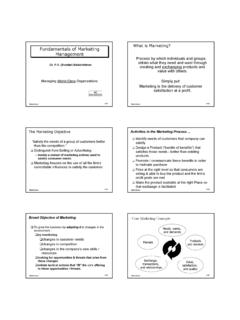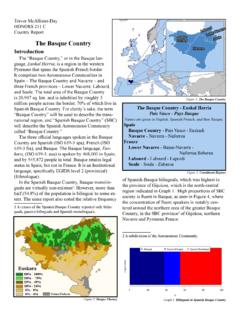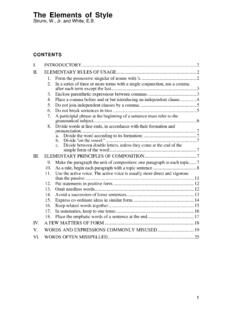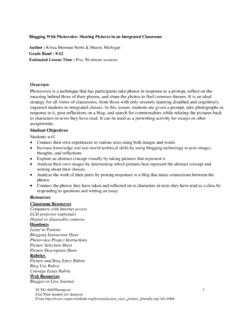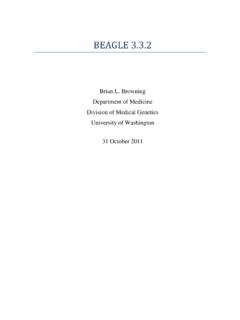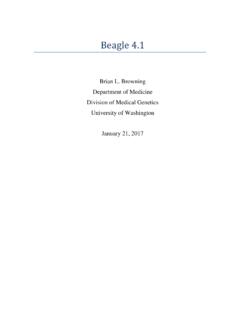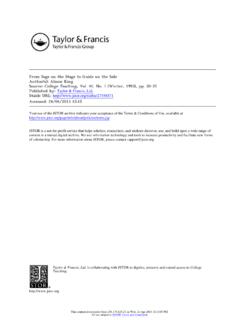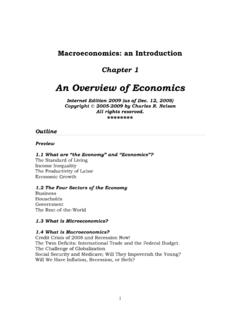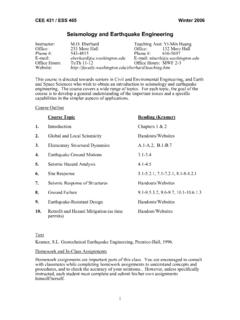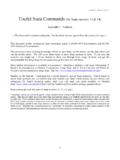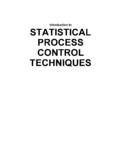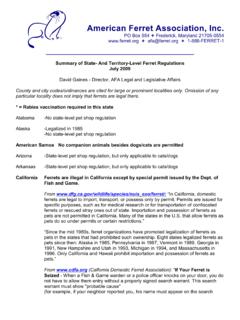Transcription of Tolerance Stack Analysis Methods - faculty.washington.edu
1 Tolerance Stack Analysis Methods Fritz Scholz . Research and Technology Boeing Information & Support Services December 1995. Abstract The purpose of this report is to describe various Tolerance stacking Methods without going into the theoretical details and derivations behind them. For those the reader is referred to Scholz (1995). For each method we present the assumptions and then give the Tolerance stacking formulas. This will allow the user to make an informed choice among the many available Methods . The Methods covered are: worst case or arithmetic tolerancing, simple statistical tolerancing or the RSS method, RSS Methods with in ation factors which account for nonnormal distributions, toleranc- ing with mean shifts, where the latter are stacked arithmetically or statistically in di erent ways, depending on how one views the trade- o between part to part variation and mean shifts.
2 Boeing Information & Support Services, Box 3707, MS 7L-22, Seattle WA 98124-2207, e-mail: Glossary of Notation by Page of First Occurrence term meaning page , i standard deviation, describes spread of a statistical 2, 15. distribution for part to part variation Li actual value of ith detail part length dimension 4. G gap, assembly criterion of interest, 4. usually a function (sum) of detail dimensions i nominal value of ith detail part dimension 4. Ti Tolerance value for ith detail part dimension 6. nominal gap value, assembly criterion of interest 6. i di erence between actual and mean (nominal) value 6.
3 Of ith detail part dimension: i = Li i if mean i = nominal i , and i = Li i if i = i ai coe cient for the ith term in the linear 7. Tolerance Stack : G = a1 L1 + .. + an Ln , often we have ai = 1. Xi actual value of ith input to sensitivity Analysis ; 7. in length stacking Xi and Li are equivalent Y output from sensitivity Analysis ; 7. in length stacking Y and G are equivalent i Glossary of Notation by Page of First Occurrence term meaning page f smooth function relating output to inputs 7. in sensitivity Analysis : Y = f (X1 , .. , Xn ). Y = f (X1 , .. , Xn ) a0 + a1 X1 + .. + an Xn ai = f ( 1.)
4 , n )/ i , i = 1, .. , n a0 = f ( 1 , .. , n ) a1 1 .. an n i nominal value of ith input to sensitivity Analysis 8. in length stacking i and i are equivalent nominal output value from a sensitivity Analysis 8. in length stacking and are equivalent Tassy generic assembly Tolerance derived by any method 9. Tassy arith assembly Tolerance derived by arithmetic 11. Tolerance stacking (worst case method). Tassy arith = |a1 | T1 + .. + |an | Tn Tdetail Tolerance common to all parts 11. i Tolerance ratio i = Ti /T1 11. Tassy stat assembly Tolerance derived by statistical 14. Tolerance stacking (RSS method).
5 Tassy stat = a21 T12 + .. + a2n Tn2. ii Glossary of Notation by Page of First Occurrence term meaning page Tassy stat (Bender) assembly Tolerance derived by statistical 16. Tolerance stacking (RSS method). using Bender's in ation factor of . Tassy stat = a21 T12 + .. + a2n Tn2. ci , c, c in ation factor for part variation distribution 17. Tassy stat (c) assembly Tolerance derived by statistical 19. Tolerance stacking (RSS method) using distributional in ation factors Tassy stat (c) = Tassy stat (c1 , .. , cn ).. = (c1 a1 T1 )2 + .. + (cn an Tn )2. k delimiter for the rectangular portion of the 21.
6 Trapezoidal density p area of middle box of DIN-histogram density 23. g half width of middle box of DIN-histogram density 23. i actual process mean for ith detail part dimension 25. i shift of process mean from nominal: i = i i 25. i , fraction of absolute mean shift in relation to Ti 25, 26. i = | i |/Ti , = ( 1 , .. , n ). iii Glossary of Notation by Page of First Occurrence term meaning page Li , Ui lower and upper Tolerance /speci cation limits: 25. Li = i Ti , Ui = i + Ti Cpk a process capability index which accounts for 25. mean shifts Tassy ,arith,1. ( ) assembly Tolerance derived by arithmetic 26.
7 Stacking of mean shifts and RSS stacking of remaining normal variation; xed Ti with tradeo between mean shift and part variation Tassy ,arith,1. ( ) = Tassy ,arith,1. ( 1 , .. , n ). = 1 |a1 |T1 + .. + n |an |Tn . + [(1 1 )a1 T1 ]2 + .. + [(1 n )an Tn ]2. Ti part Tolerance based on part to part variation, 28, 31. either Ti = 3 i or Ti = half width of distribution interval Tassy ,arith,2. ( ) assembly Tolerance derived by arithmetic 28. stacking of mean shifts and RSS stacking of remaining normal variation; in ated Ti to accommodate mean shifts ( i Ti ) under xed Ti = 3 i = Ti /(1 i ) part variation Tassy ,arith,2.
8 ( ) = Tassy ,arith,2. ( 1 , .. , n ). = 1 |a1 |T1 /(1 1 ) + .. + n |an |Tn /(1 n ).. + (a1 T1 )2 + .. + (an Tn )2. iv Glossary of Notation by Page of First Occurrence term meaning page Tassy ,arith ( , c) assembly Tolerance derived by statistical 29. stacking (RSS method) using distributional in ation factors and arithmetic stacking of mean shifts Tassy ,arith ( , c) = 1 |a1 | T1 + .. + n |an | Tn . + [(1 1 )c1 a1 T1 ]2 + .. + [(1 n )cn an Tn ]2. standard deviation for mean shift distribution 33. c ,i , c , c , in ation factors for mean shift distributions 33, 33, 35. Tassy ,stat,1. ( , c, c ) assembly Tolerance derived by RSS stacking 34.
9 Of mean shifts, RSS stacking of part variation and arithmetically stacking these two, assuming xed part variation expressed through Ti .. Tassy ,stat,1. ( , c, c ) = c21 a21 T1 2 + .. + c2n a2n (1 n )2 Tn 2.. + c2 ,1 a21 12 T1 2 /(1 1 )2 + .. + c2 ,n a2n n2 Tn 2 /(1 n )2. Ri , R relative mean shift R = (R1 , .. , Rn ) 37. Ri = i /( i Ti ), 1 Ri 1. (Ri ) standard deviation of Ri 37. v Glossary of Notation by Page of First Occurrence term meaning page wi a Tolerance weight factor 38. n n wi = ai Ti / j=1 a2j Tj2 , i=1 wi2 = 1. F (R) in ation factor for given mean shift factor R 38. Tassy ,stat,2.
10 ( ) assembly Tolerance derived by RSS stacking of 39. mean shifts and RSS stacking of part variation which can increase with decrease in mean shifts;. is the common bound on all part mean shift fractions . Tassy ,stat,2. ( ) = 1 + 2 /2 + 3.. a21 T12 + .. + a2n Tn2. Tassy ,arith,r ( , c) reduced assembly Tolerance using the factor .927 41. on the RSS part of Tassy ,arith ( , c). Tassy ,arith,r ( , c) = 1 |a1 | T1 + .. + n |an | Tn . +.927 [(1 1 )c1 a1 T1 ]2 + .. + [(1 n )cn an Tn ]2. vi 1 Introduction and Overview Tolerance Stack Analysis Methods are described in various books and pa- pers, see for example Gilson (1951), Mansoor (1963), Fortini (1967), Wade (1967), Evans (1975), Cox (1986), Greenwood and Chase (1987), Kirschling (1988), Bj rke (1989), Henzold (1995), and Nigam and Turner (1995).
